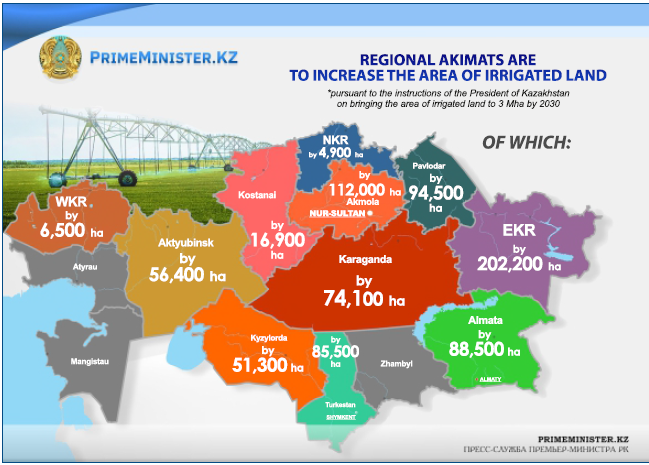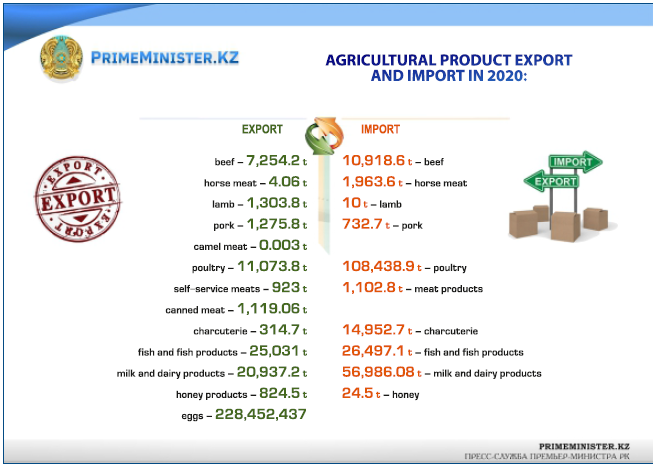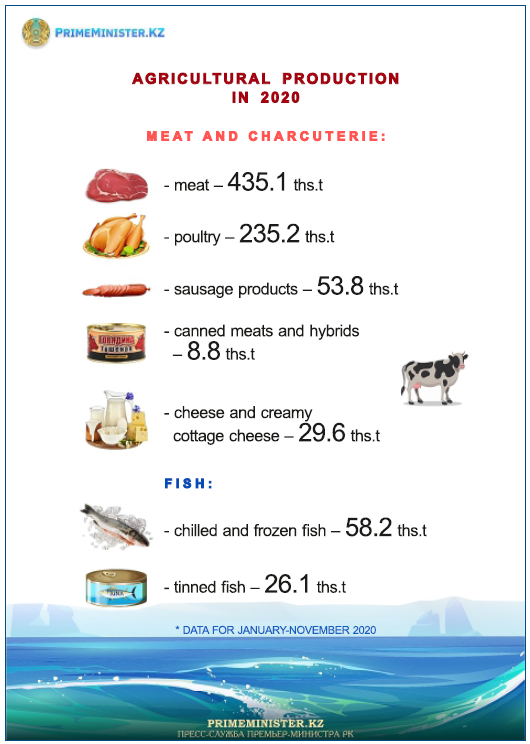
Section 5. Key water developments in the countries of Central Asia
5.1. Kazakhstan

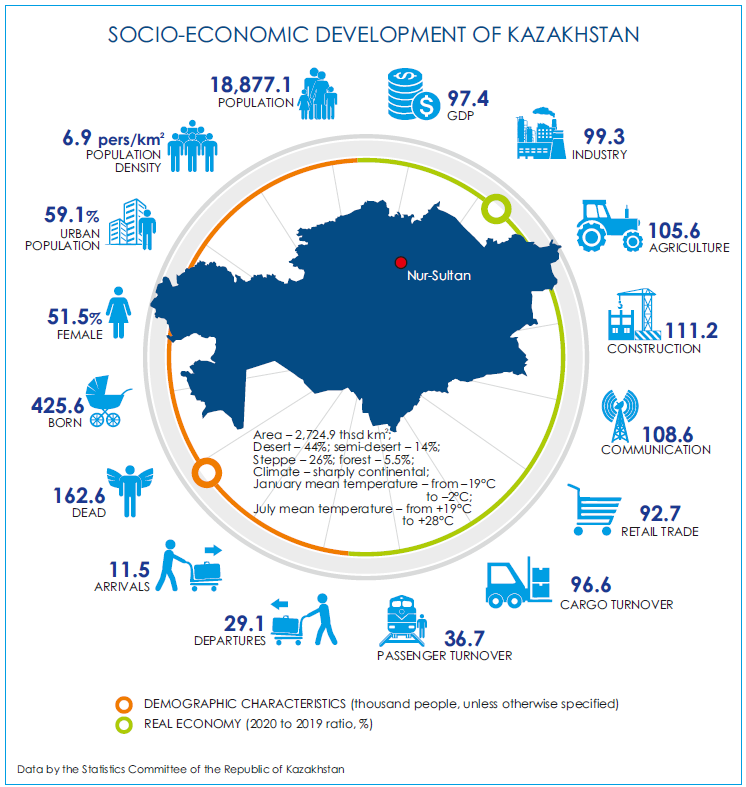
Water Sector
Water resources. There are 85 thousand rivers, with the largest of them the Irtysh, Ishim, Ural, Syr Darya, Ile, Chu, Tobol, and 48 thousand large and small lakes in Kazakhstan. The largest lakes are the Caspian Sea and the Aral Sea, followed by Balkhash, Zaisan and Alakol lakes. The rivers are fed mainly by glaciers. The total quantity of water in rivers is 101 km3, of which 57 km3 are formed within the republican boundaries. The remaining quantity the country gets from neighboring countries: Russia – 8 km3; China – 19 km3; Uzbekistan – 15 km3; Kyrgyzstan – 3 km3. The available water supply in Kazakhstan is 37 thousand m3/km2 or 6 thousand m3 per inhabitant a year.
Water management. The Committee for Water Resources at the Ministry of Ecology, Geology and Natural Resources (MEGNR) is responsible for water management in Kazakhstan.
Latest developments in legislation. Orders of the Prime Minister of RK "On the establishment of a working group for drafting a State Water Management Program 2020-2030" (66-p of 11.05.2020) and "On amending the Prime Minister’s Order of 15 March 2019 concerning the Special Representative of the Prime Minister for transboundary water and water-energy cooperation" (123-p of 23.09.2020); orders of the Minister of EGNR: "On approval of the Rules for allocating water for individual or joint use on a competitive basis" (178 of 30.07.2020), "On amending the Agricultural Minister’s order of 31 March 2015 on the approval of the list of particularly important group and local water supply systems classified as sources having no alternative (20 of 22.01.2020), "On approval of the Rules for public geology and water services " (117 of 22.05.2020), "On amending the order (1 September 2016) on the Rules for getting approval for location of enterprises and other structures, as well as the conditions of construction and other actions in watercourses, water protection zones and strips" (148 of 18.06.2020), "On approving the rules for public services related to regulation of water uses" (216 of 11.09.2020); and, order of the Minister of Agriculture "On amending the order (30 June 2015) on approval of the rules for subsidizing the cost of water supply services for agricultural producers" (185 of 26.05.2020).
New appointments. Mr. Nurlan Aldamjarov was appointed Chairman of the Committee for Water Resources by the Minister of EGNR on 19 June.
National programs. A Concept of the Water Management Program of the Republic of Kazakhstan for 2020-2030 was approved. The Program includes ten main areas: international cooperation, revision of the regulatory framework, institutional reform, modernization and reconstruction of water infrastructure, water market development, water digitalization, Smart Water, environmentally optimal use of water resources, water training, and implementation of important national water projects. The Program aims to maintain water budget at 100 km3 by 2030 through additional surface water resources, including: new reservoirs - 5-7 km3; water saving - up to 5 km3; and, groundwater - up to 15 km3. By the indicated period, it is planned to achieve reduction in water consumption from 91.2 to 73.0 m3 per $1,000, build 26 new hydraulic structures, and reconstruct 182 republican and 300 municipal hydraulic structures. The Program sets to construct new irrigation systems to expand irrigated area from 1.7 to 3 Mha, and extend lined main and distribution canals from 3,423 to 19,000 km. The logistical base of basin inspections is to be equipped by 100%, and the forest cover of catchment areas is to be extended from 1 to 200 thousand ha.
The sixth meeting of the Inter-agency Coordination Council of the National water policy dialogue was held on 20 November in Nur-Sultan. Particular attention was paid to a mechanism of cooperation between state agencies in prevention of pollution from industrial accidents and to measures implemented under the Protocol on Water and Health.
Results of the growing season 2020 In Kazakhstan the actual water withdrawal was 13.3 km3 in 2020. In Almaty province the snow cover was 35% less compared to previous years. In Zhambyl province, available water supply was 15-20% lower than the average annual data. In Turkestan province the inflow from the Syr Darya River was lower by 15% due to the fact that water volume in the Toktogul reservoir was 2 billion m3 less than in 2019. Whereas in Kyzylorda province the irrigation water deficit was exacerbated by an increase in the area under rice. Despite the challenges, the irrigation water supply plan was fulfilled.
Water infrastructure. In 2020, 813 km out of 11 thousand km of main and inter-farm canals were repaired. This helped to reduce transportation losses by 166 million m3. The rehabilitated irrigation infrastructure allowed putting 53.5 thousand ha into production. Three water pipelines were put into operation. This has improved water supply for 124,500 people in 15 rural settlements and one city.
Projects. The first pilot project on digitalization of 12-km long main canal K-19 was implemented in Makhtaaral district, Turkestan province. The installed water measurement and monitoring system allowed detecting up to 45% of irrigation water over-use. The automated water control and measurement system was implemented jointly with the Australian Rubicon company on the 3-km long inter-farm canal K-32. The canal delivers irrigation water to large agricultural producers on an area of 2,300 ha. In the light of this experience, a 5-year Plan for automation of irrigation network (2021-2025) was drafted for the automation of 119 key canals (total water diversion – approx. 6 km3) in Almaty, Zhambyl, Turkestan and Kyzylorda provinces.
More information on “Irrigation and drainage in South Kazakhstan, capacity building and awareness raising” (2017-2021) and other projects can be found in the United Nations Development Program and the Executive Directorate of IFAS in Kazakhstan, respectively.
Inter-state cooperation. In 2020, all scheduled meetings of joint water commissions between Kazakhstan and riparian states were held. An exception is a commission with China, which proposed to postpone the commission’s meeting to the first quarter 2021 due to the pandemic. Activities were continued with China at the expert level on implementation of the Work Plan on water allocation and assessment in the transboundary river basins of the Yertis, Ile and Yemel.
A meeting of the Kazakhstan-Russian Commission on the Joint Use and Protection of Transboundary Waters resulted in the adoption of a common road map for strengthening research cooperation in the Zhayik, Yertis and other river basins (29 October, Novosibirsk).
A Memorandum of Understanding on water cooperation between the Ministry of Ecology, Geology and Natural Resources of the Republic of Kazakhstan and the Ministry of Environment of the Slovak Republic was signed. Cooperation activities under the Memorandum will be implemented in the form of joint projects, information exchange and research (12 December, Bratislava).
Bilateral water cooperation with the Central Asian countries. As part of the Comprehensive Program of cooperation between the Republic of Kazakhstan and the Kyrgyz Republic for 2020-2022, the Kazakh Vice-Minister of Ecology S. Gromov held negotiations with representatives of water and energy agencies of the Kyrgyz Republic (14 February, Bishkek). See Kazakhstan - Uzbekistan for details on the meetings of the Minister of Ecology, Geology and Natural Resources of Kazakhstan M.Mirzagaliyev and the Minister of Water Management of Uzbekistan Sh.R. Khamraev and achieved results.
As a whole, 11 meetings of a working group for enhanced water cooperation between the countries were organized in 2020. In addition to regular agenda, the issues related to the breach of the Sardoba dam were addressed as well.
The 78th ICWC meeting was held under the chairmanship of Kazakhstan (10 April, online) - ICWC meetings. See also Bilateral water cooperation between the countries of Central Asia and ICWC meetings for details on the agreements reached between the Republic of Kazakhstan, the Kyrgyz Republic and the Republic of Uzbekistan on additional water releases from reservoirs in the Syr Darya River basin during the growing season.
Agriculture
New appointments. Mr. R. Manatayev was appointed Vice-minister of Agriculture by a Governmental Decree on 17 August.
The Ministry of Agriculture of Kazakhstan developed and submitted to local executive bodies an algorithm for movement of agricultural producers during the COVID-19 pandemic, which was approved at a meeting of the State Emergency Regime Commission under the President of Kazakhstan (15 April). Amendments were made to the resolution of the Chief State Sanitary Doctor of the Republic of Kazakhstan to ensure free movement of persons involved in spring field work. Thanks to the above measures, the total crop acreage amounted to 22.7 Mha or 0.5 Mha more than in 2019. In 2020, agricultural workers harvested more than 20.8 Mt of grain in initial weight.
Programs in support of Kazakh agricultural producers during the state of emergency. The following support measures were taken: exemption of agricultural producers from the agricultural land tax until 31 December 2020; suspension of tax penalties until 15 August 2020 and shifting tax reporting to the third quarter 2020; setting of VAT on socially essential foodstuff at 8% until 1 October 2020; tax payment deferrals for all SMEs until 1 June 2020; from 1 January 2020 to 1 January 2023 persons using special tax regimes and recognized as microenterprises or small business, including payers of single land tax were exempt from taxes on income.
A comprehensive plan for economic recovery until the end of 2021 was approved on 20 May 2020 and included measures in support and development of agroindustry, such as: guaranteed purchase of agricultural produce; deferral on and restructuring of loans and leasing for farmers. In order to support agricultural producers, 12.3 billion tenge were allocated from government reserve funds and 92.4 billion tenge were allocated from the local budget for development of livestock breeding and improvement of productivity and quality of livestock products.
The proposal was supported to finance forward purchase of agricultural produce in order to ensure appropriate and timely implementation of spring field work and achieve a stable harvest. As a result, 483.8 thousand t were supplied against the plan of 365 thousand t. As a whole, under the subsidy program (1) 6803 farmers received state support for seeds; (2) agricultural producers were able to purchase 533 thousand t of mineral fertilizers, which is 131.3 more than in 2019; (3) 3,602.5 Mm3 were delivered to 828 agricultural producers for 1.86 billion tenge; (4) agricultural equipment became more affordable.
In 2020, the agroindustrial sector showed positive growth dynamics as a result of implementation of the State Program for Agroindustry Development in 2017-2021. The Ministry of Agriculture started developing a new National Program for the development of agroindustry until 2026.
Activities have been launched to bring irrigated area to 3 Mha by 2030.
By 2023, the country will be 100% self-sufficient in meat, fish and dairy products.
Projects. KazNAU jointly with the Michigan State University, the Humanitarian University of Mongolia and the Mongolian Academy of Sciences launched a research project. The project has several objectives, among which: quantifying the interdependent changes of food production, evapotranspiration and radiation balance for Kazakhstan and Mongolia during 1981-2020; quantifying the direct consequences of land use/cover change on evapotranspiration (ET) and albedo through RS-studies; exploring the indirect influences of infrastructure, farmer demography, policy, and climate within three selected provinces in each country.
KazHydromet has developed a specialized Interned-based application “AgroData”, which offers agrometeorological services to farmers and other stakeholders in Kazakhstan.
The Committee of Science at the Ministry of Education has developed highly-sensible virus detection systems for fruit and berry crops for diagnostics of seeding material and use by the phyto-sanitary control service.
As part of the FAO/GEF Regional Project “Integrated natural resources management in drought-phone and salt-affected agricultural production landscapes in Central Asia and Turkey” (CACILM-2) aimed at disseminating IWRM practices in the countries whose landscapes are prone to drought and salinity, the following events were held: (1) an online FAO meeting with the staff of the Kazakh Ministry of Agriculture and the heads of Akhal and Dashoguz province authorities. The issues related to effective management of natural resources for drought prevention were discussed during the meeting (16 September); (2) an international training webinar "Sustainable management of pasture resources in Kazakhstan" (2 October). More details on implementation of other FAO projects are available in Food and Agriculture Organization.
Energy
2020 results. Thermal power plants still dominate in the structure of electricity production: their share is 88% (including gas turbine power plants), the share of hydroelectric power plants is 9%, and renewable energy sources account for 3%. There are two stable trends - an increase in generation from renewable energy sources and a reduced generation at hydroelectric power plants, while coal and gas thermal power plants continue to increase production. In 2020, thermal power plants generated 0.4% more electricity than last year, and hydroelectric power plants – 4.3% less. Oil and condensate production amounted to 85.7 million t, oil export - 68.5 million t, oil refining - 15.8 million t, and production of oil products - 11.5 million t. Gas production was 55.1 billion m3, marketable gas production was 30.5 billion m3, and the export was 10.7 billion m3.
Latest developments in legislation. In 2020, the Kazakh Ministry of Energy initiated the adoption of 104 regulatory acts, including three laws, one Presidential Decree, 28 Governmental Decrees, etc. The adopted laws in particular were about: the ratification of the Agreement between Kazakhstan and the Russian Federation on gas supply to Baikonur (305-VІ of 26.03.20); amendments to regulatory documents in part of responsibility in the area of nuclear energy use (329-VI of 14.05.2020); amendments to regulatory documents regarding expansion of renewable energy (380-VI of 07.12.2020). The latter creates conditions for the construction of new maneuvering capacities, introduces a mechanism for the centralized purchase and sale of flood power, increases the period of purchase of RES and provides for the obligation to sell hydropower generated in the period of environmental water releases at centralized auctions.
New appointments. Mr. A. Shangitbaev was appointed Chairman of the Committee for Atomic and Energy Supervision and Control at the Ministry of Energy.
RES
As part of the national green economy concept, in 2020 the share of renewables in the total energy budget of the country was increased to 3%. By the end of the year, 115 RES facilities with the total capacity of 1,634.7 MW (29 wind stations – 486.3 MW; 43 solar stations – 911.6 MW; 38 HPPs – 229.04 MW; 5 biofuel power plants – 7.82 MW) were operational. The output from RES was 3.2 billion kWh or 32.2% more than in 2019.
The most dynamic growth is recorded in the solar energy segment, the generation of which increased by 140% (up to 1,350 million kWh) in one year and 15 times in five years. Production of wind energy increased fourfold for a five-year period and amounted to 1077 million kWh (+50% for the year) by the end of 2020. Small hydropower produced 812 million kWh or 27% less power than in 2019.
In 2020, 16 companies won tenders for RES construction with the total installed capacity of 148 MW: three wind stations for 65 MW; four solar stations for 60 MW; and, nine small hydropower for 23 MW. Most of approved RES capacity is located in energy deficient south zone of the national energy system.
In 2020, solar power stations were commissioned in: (1) Akmola province – “Nura” (100 MW) - the largest one in the CIS space with a projected annual output of 150 million kWh; (2) Turkestan province - Yuxes-50 for 50 MW; (3) Karaganda province, for 26 MW, with an annual output of 34 million kWh; (4) Zhetysai district, Turkestan province – “Zhetysai” (4.8 MW) with a projected annual output of 7.2 million kWh; (5) Almaty province - "Sarybulak" (4.95 MW) and "Kapshagai" (3 MW) with a projected annual output of 14.1 million kWh at the both stations.
Environment and Climate Change
Latest developments in legislation. The new draft Environmental Code was approved on 19 November. The following regulatory documents were adopted also: (1) the law on amending and supplementing the Code on administrative offenses in environmental sector (403-VI of 02.01.2021) and on amending and supplementing legislative acts on designated conservation areas (362-VI of 30.09.2020); (2) Governmental decrees on the draft law on fauna (921 of 30.12.2020) and the draft law on ratification of the Protocol on environmental impact assessment in a transboundary context to the Convention for the protection of the marine environment of the Caspian Sea (923 of 30.12.2020); (3) Order of the Minister of EGNR on amending the order of the Ministry of Energy of 26 February 2015 regarding the approval of the Rules for setting environmental quality targets (111 of 19.05.2020).
The Program for Fishery Development until 2030 has been adopted adopted; territorial branches of the Committee for Forestry and Wildlife were re-organized.
New appointments. Serikkali Brekeshev was appointed Deputy Minister of Ecology, Geology and Natural Resources of the Republic of Kazakhstan (March 5); Erlan Muratov was appointed Deputy Chairman of the Committee for Forestry and Wildlife under the Ministry of Environmental Protection and Natural Resources (MENR) of the Republic of Kazakhstan (April 15).
Projects and programs. The 2020 results on the development of environmental initiatives, forestry and wildlife, improvement of legislation and measures of state support in the environmental sector were summed up at an enlarged meeting of the Board of MENR. The tasks were set for 2021, in particular: (1) develop a national project "Zhasyl Kazakhstan"; (2) control the implementation of comprehensive plans for forest reproduction and afforestation; (3) improve the regulatory framework in the field of forestry and protected areas; (4) develop a network of designated conservation areas and ecological tourism.
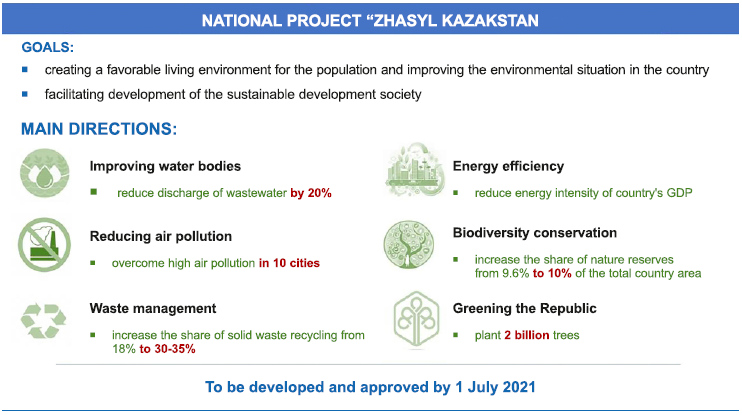
As part of the projects (1) "Afforestation of the dried bottom of the Aral Sea in Kyzylorda province" (2018-2020), the Committee for Forestry and Wildlife together with the Korean Forest Service of the Republic of Korea and the Foundation for Biodiversity Conservation of Kazakhstan planted 5 million saxaul seedlings on an area of 13.3 thousand ha; (2) CACILM-2, the research on climate-related disaster risk management, early warning and agrometeorological services was started.
For more details on projects in the area of natural resource management, land and ecosystems, climate change, and the SDGs, please, see United Nations Development Program.
Events. Nur-Sultan was ranked 2nd in fastest growing ecosystems in the Global Startup Ecosystem Report 2020. Also, Nur-Sultan showed the highest score on the Environmental Finance Index (June 25).
171 businesses joined the Earth Hour in Kazakhstan on 28 March. As part of the "World Cleanup Day", a tree planting action took part throughout the country upon the initiative of MEGNR.
Environmental education. The President of Kazakhstan proposed to introduce the school subject “Environmental education” (10 July, enlarged meeting of the Government). An agreement was reached to establish a Coordinating Council for Environmental Education (18 August). The Ministry of Education and Science launched a project with the UN to increase the level of environmental culture and education in the academic year 2020-2021.
International cooperation
Kazakhstan and the UN signed a Cooperation Agreement for the period of 2021-2025. The framework program covers three areas of work: human development and equal participation; effective institutions, human rights and gender equality, sustainable environment and inclusive economic development (12 August). The President of Kazakhstan took part in a video conference dedicated to the 75th UN anniversary (21 September).
During the meeting of Mr. Mirzagaliyev with the Mr. Kozlov, Minister of Natural Resources and Environment of the Russian Federation a number of documents were signed in the field of environmental protection and rational nature use, including the Program of Russian-Kazakhstan cooperation on conservation and restoration of the transboundary Ural basin ecosystem for 2021-2024, and the Program of cooperation between the two countries to preserve and restore the ecosystem of the transboundary Irtysh River for 2021-2024 was adopted (4 December, Moscow).
Kazakhstan took part in an informal meeting of environmental ministers from the Caspian riparian states. The ministers discussed the issues related to cooperation in monitoring the Caspian Sea, the impact of climate change on the sea ecology, the state of bio-resources, as well as measures to prevent pollution of the coastal zone (9 June).
Emergencies and disasters
Sardoba dam accident in the Syrdarya province of Uzbekistan. As a result of the accident, the border collecting drains in Maktaaral district, Turkestan province of Kazakhstan were overfilled with water and this caused flooding (1 May). More than 5,000 people had to leave their homes and about 500 ha of pastures were flooded. Presidents of Kazakhstan and Uzbekistan discussed how to organize effective cooperation to overcome the consequences of the emergency accident in border regions of the countries. The Government Commission on mitigation of flooding consequences in Turkestan province was formed (4 May). See details in Sardoba Dam Collapse.
In 2020, forest fires covered an area of 41.8 thousand ha. The more significant acreage was burned in Zhambyl, East Kazakhstan, West Kazakhstan, Pavlodar and Turkestan provinces, as well as in the "Semei ormany" reserve. The total damage from the fires amounted to 2.1 billion tenge.
As a result of rising water level along the Lengerka River and overflowing, settlements were waterlogged in Tole Bi district of Turkestan province (6 May). More than 300 people were evacuated from the zones of flooding by rainwater in Shymkent (14 May).
Sources
Official sites of: the President of Kazakhstan, Ministry of Ecology, Geology and Natural Resources, Ministry of Agriculture, Ministry of Energy, Legal Information System of RK
Information agencies: inbusiness.kz, ainews.kz, kazenergy.com, forbes.kz, kursiv.kz, informburo.kz, liter.kz, kazaral.org, kazakh-zerno.net, inform.kz, kaztag.kz, centrasia.org
